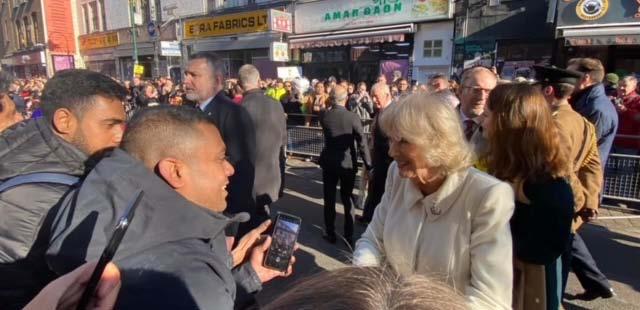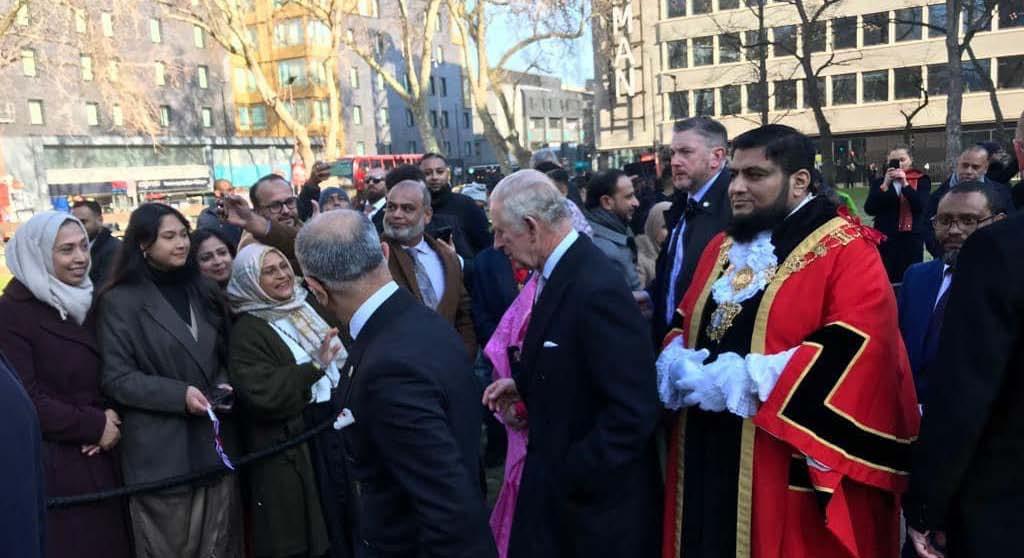
3 minute read
King Charles III and Queen Consort Camilla visited Banglatown in East London
By Muhammed Shahed Rahman :
King Charles III and Queen Consort Camilla visited Altab Ali Park, Bricklane and Bricklane Jame Masjid in East London's Bengalidominated Banglatown.

On Wednesday, February 8, 2023, at 11 a.m., the King first arrived at Altab Ali Park, a memorial to the British Bengali antiapartheid movement.
When the King and Queen Consort Camilla arrived, they were welcomed by Ayesha Qureshi MBE JP, founder of British Bangladeshi Power and Inspiration (BBPI), the organizer of the royal visit, and Councilor Abdal Ullah.
At Altab Ali Park, the King and Queen Consort Camilla were briefed on the brief history of the Bengali anti-apartheid movement in London and Shaheed Minar, the martyr of the Bengali language movement, by various community leaders present. .
The King and Queen spoke to British Bengalis active in the antiapartheid movement of the sixties, seventies and eighties.
Then the king moved to Bricklane. King Charles III and Camilla exchanged greetings with the crowds lined up in Banglatown's famous Bricklane and with the incoming students of the new generation of schools, colleges and universities. Meanwhile, people from other communities including Bengalis welcomed the King by standing with British flags on both sides of the road. British Bangladeshi dancers performed Bengali dances before the King. The King and Queen Consort Camelia shake hands with British Bangladeshis standing on both sides of the road.
In Bangla Town, the King was entertained with Pithapuli, a traditional dish of Bangladesh. The Queen Consort was gifted a Jamdani saree, a souvenir of Bangladeshi heritage. Then the King came to visit Bricklane Jame Masjid. Members of the Mosque Trust welcomed the royal couple as well as presented the history of the Bricklane Mosque. This is his first visit to Banglatown after taking over as king. Before development of Britain, various achievements along the history of four generations of struggle of the Bangladeshi community in Britain. The arrival of immigrants from Bangladesh to Britain began in the thirties of the last century. People from the greater Sylhet region initially started the search of education and employment. Thus once a large society of people of greater Sylhet region was formed in Britain. In the sixties and seventies of the last century in various cities of Britain, including London, the activities of some radical white nationalist organizations began to increase continued to increase. In one such violent racist attack, a Bengali garment worker named Altab Ali was killed on May 4, 1978 at the age of 24. Altab Ali was born in 1953 in Mollaata village of Sairdargaon union of Chatak upazila of Sunamganj district. In protest of the murder in a racist attack, Bengalis and other immigrants staying in Britain erupted into protests. In June 1978, another Bengali racist named Ishaq Ali was killed in another such racist attack in the Hackney area. Born in Mollaata village of Union. In protest of the murder of Altab Ali in a racist attack, Bengalis and other immigrants staying in Britain erupted into protests. In June 1978, another Bengali racist named Ishaq Ali was killed in another such racist attack in the Hackney area. becoming king, Prince Charles visited the East London Mosque in 2001. Before that, in 1987, he came to Bricklane to inspect the progress of a project. But, today's visit is of special significance to inspire the British-Bangladeshis' incredible achievements in various sectors in the process of migration from Calcutta to work in British shipping companies. After World War II, the British government welcomed large numbers of immigrants from the colonies due to labor shortages. Gradually people from other classes and professions migrated to Britain in alarmingly. Various antiimmigrant activities of these organizations, For example, hatred and racism were spreading. Bangladeshis were their target. As a result, violent racist attacks on immigrants from different countries, including Bangladeshis staying in the UK and London, of Altab Ali in a racist attack, Bengalis and other immigrants staying in Britain erupted into protests. In June 1978, another Bengali racist named Ishaq Ali was killed in another such racist attack in the Hackney area. Born in Mollaata village of Union. In protest of the murder of Altab Ali
Altab Ali's death has sparked widespread protests in East London's Bricklane area against rising racism and racist attacks on migrants. Bangladeshi activists joined the anti-apartheid movement. Ten days after Altab Ali's death, around 7,000 people marched and demonstrated in front of London's Hyde Park, Trafalgar Square and 10 Downing Street, the official residence of the British Prime Minister, and protesters called for immediate action to stop xenophobia and racist attacks in the immigrantdominated area of east London. Demand to the government. A massive anti-apartheid rally was held on September 24 that year. Lakhs of people of different religions and communities participated in that rally.
Later, various actions of the British government and especially the movement of Bengali immigrants gradually reduced the racist attacks in East London. In 1989 an arch was erected in St Mary's Park in memory of all victims of apartheid.
Later in 1998 the name of the park was changed to 'Altab Ali Park'. On February 21, 1952, a Shaheed Minar was built inside this park in memory of the martyrs demanding the establishment of Bengali as the national language. Every year on May 4th 'Altab Ali Day' is celebrated in UK.










